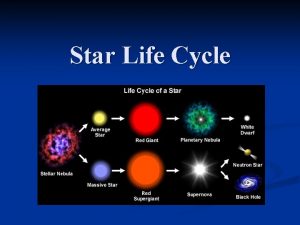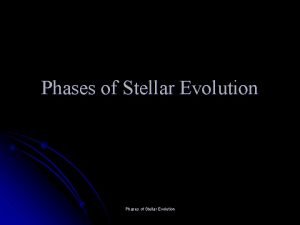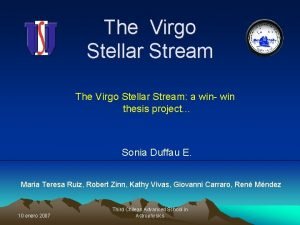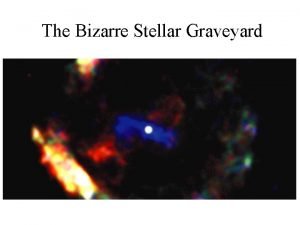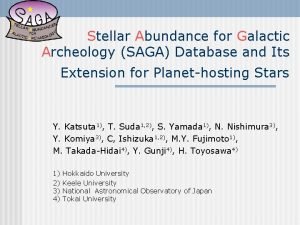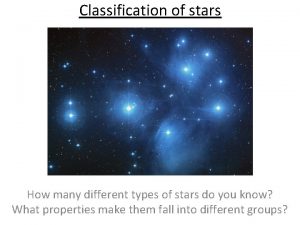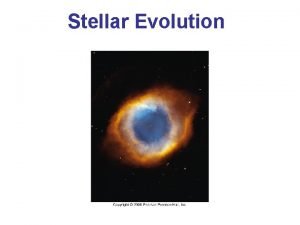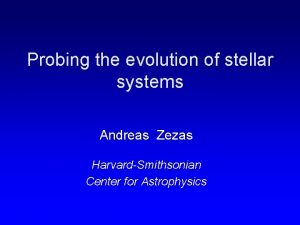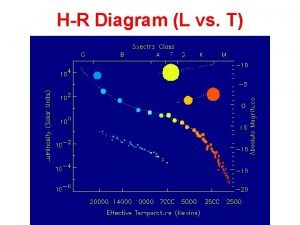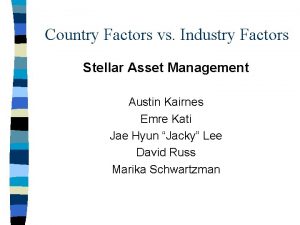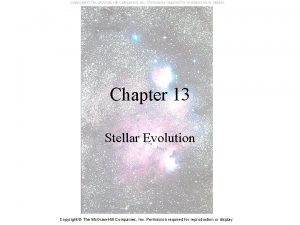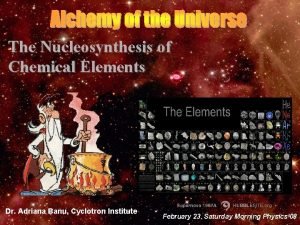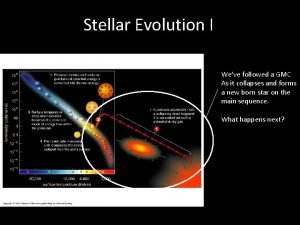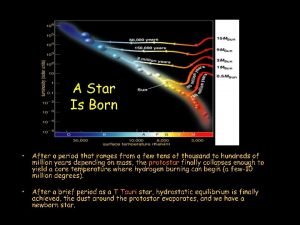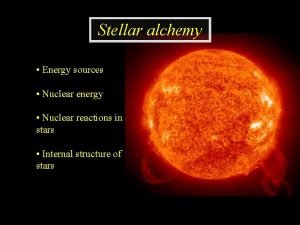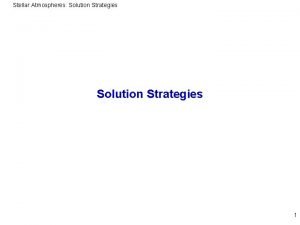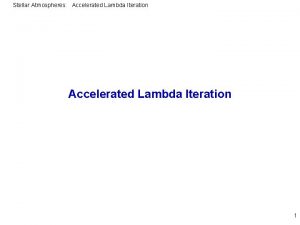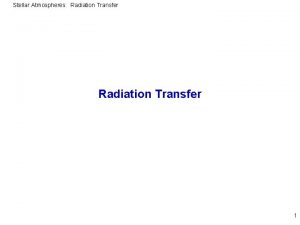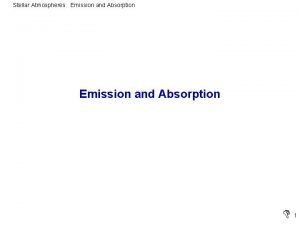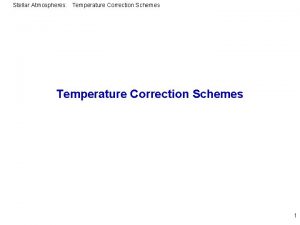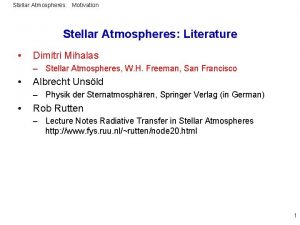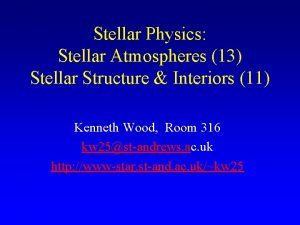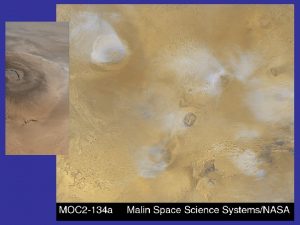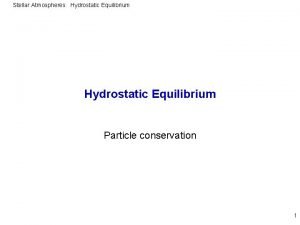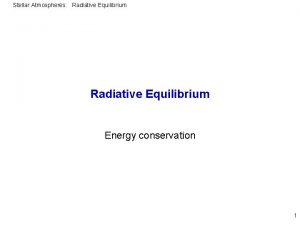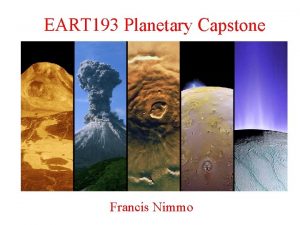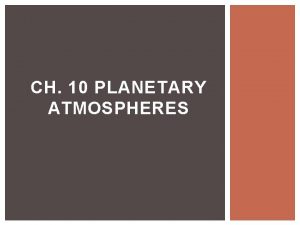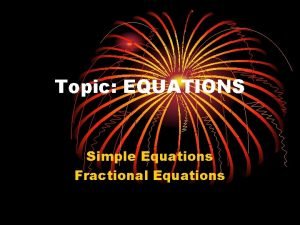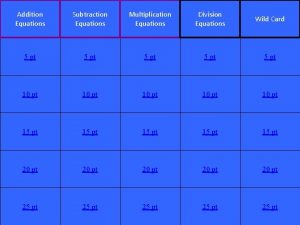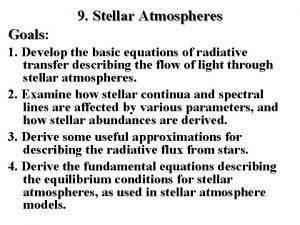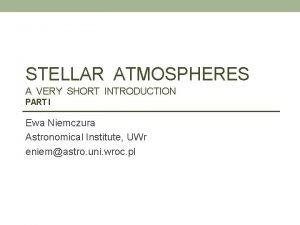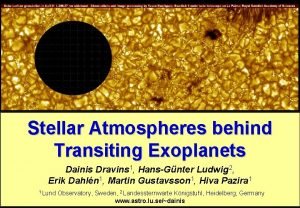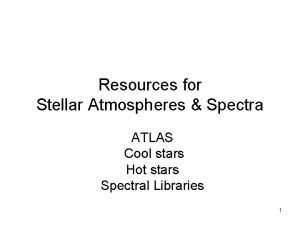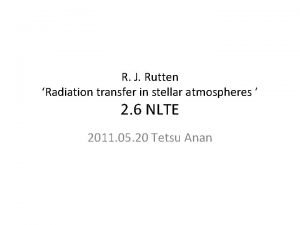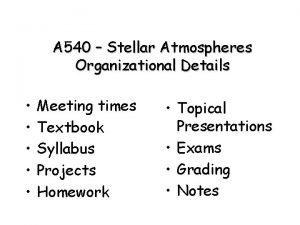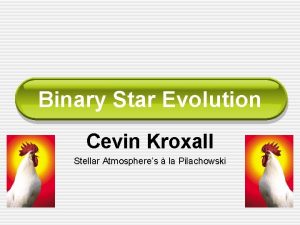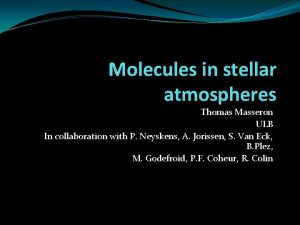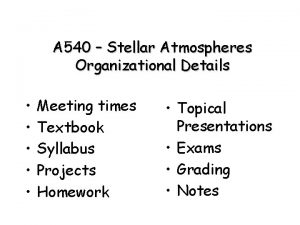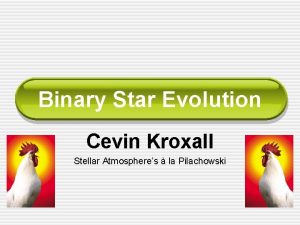Stellar Atmospheres NonLTE Rate Equations The nonLTE Rate

































- Slides: 33

Stellar Atmospheres: Non-LTE Rate Equations The non-LTE Rate Equations Statistical equations 1

Stellar Atmospheres: Non-LTE Rate Equations Population numbers LTE: population numbers follow from Saha-Boltzmann equations, i. e. purely local problem Non-LTE: population numbers also depend on radiation field. This, in turn, is depending on the population numbers in all depths, i. e. non-local problem. The Saha-Boltzmann equations are replaced by a detailed consideration of atomic processes which are responsible for the population and de-population of atomic energy levels: Excitation and de-excitation by radiation or collisions Ionization and recombination 2

Stellar Atmospheres: Non-LTE Rate Equations Statistical Equilibrium Change of population number of a level with time: = Sum of all population processes into this level - Sum of all de-population processes out from this level One such equation for each level The transition rate comprises radiative rates and collision rates In stellar atmospheres we often have the stationary case: These equations determine the population numbers. 3

Stellar Atmospheres: Non-LTE Rate Equations Radiative rates: bound-bound transitions Two alternative formulations: a) Einstein coefficients b) Line absorption coefficients advantage a): useful for analytical expressions with simplified model atoms advantage b): similar expressions in case of bound-free transitions: good for efficient programming Number of transitions i j induced by intensity I in frequency interval d und solid angle d Integration over frequencies and angles yields Or alternatively 4

Stellar Atmospheres: Non-LTE Rate Equations Radiative rates: bound-bound transitions In analogy, number of stimulated emissions: Number of spontaneous emissions: Total downwards rate: 5

Stellar Atmospheres: Non-LTE Rate Equations Radiative rates: bound-free transitions Also possible: ionization into excited states of parent ion Example C III: Ground state 2 s 2 1 S Photoionisation produces C IV in ground state 2 s 2 S C III in first excited state 2 s 2 p 3 Po Two possibilities: Ionization of 2 p electron → C IV in ground state 2 s 2 S Ionization of 2 s electron → C IV in first excited state 2 p 2 P C III two excited electrons, e. g. 2 p 2 3 P Photoionization only into excited C IV ion 2 p 2 P 6

Stellar Atmospheres: Non-LTE Rate Equations Radiative rates: bound-free transitions Number of photoionizations = absorbed energy in d , divided by photon energy, integrated over frequencies and solid angle Number of spontaneous recombinations: 7

Stellar Atmospheres: Non-LTE Rate Equations Radiative rates: bound-free transitions Number of induced recombinations Total recombination rate 8

Stellar Atmospheres: Non-LTE Rate Equations Radiative rates Upward rates: Downward rates: Remark: in TE we have 9

Stellar Atmospheres: Non-LTE Rate Equations Collisional rates Stellar atmosphere: Plasma, with atoms, ions, electrons Particle collisions induce excitation and ionization Cool stars: matter mostly neutral frequent collisions with neutral hydrogen atoms Hot stars: matter mostly ionized collisions with ions become important; but much more important become electron collisions Therefore, in the following, we only consider collisions of atoms and ions with electrons. 10

Stellar Atmospheres: Non-LTE Rate Equations Electron collisional rates Transition i j (j: bound or free), ij (v) = electron collision cross -section, v = electron speed Total number of transitions i j: minimum velocity necessary for excitation (threshold) velocity distribution (Maxwell) In TE we have therefore Total number of transitions j i: 11

Stellar Atmospheres: Non-LTE Rate Equations Autoionization and dielectronic recombination negative 0 ion I, e. g. d He I ion II, e. g. He II c ionization energy positive Energy b b bound state, d doubly excited state, autoionization level c ground state of next Ion d c: Autoionization. d decays into ground state of next ionization stage plus free electron c d b: Dielectronic recombination. Recombination via a doubly excited state of next lower ionization stage. d autoionizes again with high probability: Aauto=1013. . . 1014/sec! But sometimes a stabilizing transition d b occurs, by which the excited level decays radiatively. 16

Stellar Atmospheres: Non-LTE Rate Equations Complete rate equations For each atomic level i of each ion, of each chemical element we have: In detail: excitation and ionization rates out of i de-excitation and recombination rates into i excitation and ionization 20

Stellar Atmospheres: Non-LTE Rate Equations Closure equation One equation for each chemical element is redundant, e. g. , the equation for the highest level of the highest ionization stage; to see this, add up all equations except for the final one: these rate equations only yield population ratios. We therefore need a closure equation for each chemical species: Abundance definition equation of species k, written for example as number abundance yk relative to hydrogen: 21

Stellar Atmospheres: Non-LTE Rate Equations Abundance definition equation Notation: Population number of level i in ionization stage l : nl, i LTE levels do not appear explicitly in the rate equations; populations depend on ground level of next ionization stage: NLTE levels E 0 22

Stellar Atmospheres: Non-LTE Rate Equations Abundance definition equation Notation: NION number of ionization stages of chemical element k NL(l) number of NLTE levels of ion l LTE(l) number of LTE levels of ion l Also, one of the abundance definition equations is redundant, since abundances are given relative to hydrogen (other definitions don‘t help) charge conservation 23

Stellar Atmospheres: Non-LTE Rate Equations Charge conservation equation Notation: Population number of level i, ion l, element k: nkli NELEM number of chemical elements q(l) charge of ion l 24

Stellar Atmospheres: Non-LTE Rate Equations Complete rate equations: Matrix notation Vector of population numbers One such system of equations per depth point Example: 3 chemical elements Element 1: NLTE-levels: ion 1: 6, ion 2: 4, ion 3: 1 Element 2: NLTE-levels: ion 1: 3, ion 2: 5, ion 3: 1 Element 3: NLTE-levels: ion 1: 5, ion 2: 1, hydrogen Number of levels: NLALL=26, i. e. 26 x 26 matrix 25

Stellar Atmospheres: Non-LTE Rate Equations Ionization into excited states LTE contributions abundances 26

Stellar Atmospheres: Non-LTE Rate Equations Elements of rate matrix For each ion l with NL(l) NLTE levels one obtains a submatrix with the following elements: 27

Stellar Atmospheres: Non-LTE Rate Equations Elements corresponding to abundance definition eq. Are located in final row of the respective element: 28

Stellar Atmospheres: Non-LTE Rate Equations Elements corresponding to charge conservation eq. Are located in the very final row of rate matrix, i. e. , in Note: the inhomogeneity vector b (right-hand side of statistical equations) contains zeros except for the very last element (i=NLALL): electron density ne (from charge conservation equation) 29

Stellar Atmospheres: Non-LTE Rate Equations Solution by linearization The equation system is a linear system for and can be solved if, are known. But: these quantities are in general unknown. Usually, only approximate solutions within an iterative process are known. Let all these variables change by e. g. in order to fulfill energy conservation or hydrostatic equilibrium. Response of populations on such changes: Let with actual quantities And with new quantities Neglecting 2 nd order terms, we have: 30

Stellar Atmospheres: Non-LTE Rate Equations Linearization of rate equations Needed: expressions for: J discretized in NF frequency points One possibility: If in addition to the variables unknowns, then we have the Method of Complete Linearization are introduced as Other possibility: eliminates from the equation system by expressing through the other variables : As an approximation one uses (and iterates for exact solution) 31

Stellar Atmospheres: Non-LTE Rate Equations Linearization of rate equations Method of approximate -operators (Accelerated Lambda Iteration) 32

Stellar Atmospheres: Non-LTE Rate Equations Linearization of rate equations Linearized equation for response as answer on changes Expressions show the complex coupling of all variables. A change in the radiation field and, hence, the source function at any frequency causes a change of populations of all levels, even if a particular level cannot absorb or emit a photon at that very frequency! 33

Stellar Atmospheres: Non-LTE Rate Equations Linearization of rate equations In order to solve the linearized rate equations we need to compute these derivatives: All derivatives can be computed analytically! Increases accuracy and stability of numerical solution. More details later. 34

Stellar Atmospheres: Non-LTE Rate Equations LTE or NLTE? When do departures from LTE become important? LTE is a good approximation, if: 1) Collisional rates dominate for all transitions 2) Jv =Bv is a good approximation at all frequencies 35

Stellar Atmospheres: Non-LTE Rate Equations LTE or NLTE? When do departures from LTE become important? LTE is a bad approximation, if: 1) Collisional rates are small 2) Radiative rates are large 3) Mean free path of photons is larger than that of electrons Example: pure hydrogen plasma Departures from LTE occur, if temperatures are high and densities are low 36

Stellar Atmospheres: Non-LTE Rate Equations LTE or NLTE? 37

Stellar Atmospheres: Non-LTE Rate Equations DO with log g= 7. 5 DAO with log g= 6. 5 LTE or NLTE? 40

Stellar Atmospheres: Non-LTE Rate Equations Summary: non-LTE Rate Equations 41

Stellar Atmospheres: Non-LTE Rate Equations Complete rate equations For each atomic level i of each ion, of each chemical element we have: In detail: excitation and ionization rates out of i de-excitation and recombination rates into i excitation and ionization 42
 Stellar heaven
Stellar heaven Astronomy
Astronomy Stages of stellar evolution of a low-mass star
Stages of stellar evolution of a low-mass star Stellar evolution diagram
Stellar evolution diagram Stellar motion matlab
Stellar motion matlab Virgo stellar
Virgo stellar Stellar graveyard
Stellar graveyard Stages of stellar evolution of a low-mass star
Stages of stellar evolution of a low-mass star Stellar hosting iptv
Stellar hosting iptv Stellar assessment
Stellar assessment Stellar saga
Stellar saga What is stellar parallax?
What is stellar parallax? Stellar evolution
Stellar evolution Stellar
Stellar Stellar formation
Stellar formation Stellar asset management
Stellar asset management Stellar evolution
Stellar evolution Becquerel
Becquerel Stellar evolution
Stellar evolution Stellar evolution diagram
Stellar evolution diagram Stellar wifi
Stellar wifi Stellar alchemy
Stellar alchemy 9-3 polar and rectangular forms of equations
9-3 polar and rectangular forms of equations Translate word equations to chemical equations
Translate word equations to chemical equations Hình ảnh bộ gõ cơ thể búng tay
Hình ảnh bộ gõ cơ thể búng tay Lp html
Lp html Bổ thể
Bổ thể Tỉ lệ cơ thể trẻ em
Tỉ lệ cơ thể trẻ em Voi kéo gỗ như thế nào
Voi kéo gỗ như thế nào Tư thế worms-breton
Tư thế worms-breton Chúa sống lại
Chúa sống lại Môn thể thao bắt đầu bằng từ chạy
Môn thể thao bắt đầu bằng từ chạy Thế nào là hệ số cao nhất
Thế nào là hệ số cao nhất Các châu lục và đại dương trên thế giới
Các châu lục và đại dương trên thế giới


